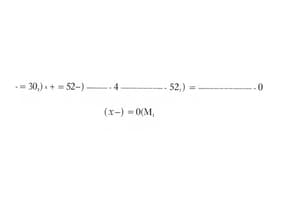Podcast
Questions and Answers
Which term describes music that is considered serious and of enduring value?
Which term describes music that is considered serious and of enduring value?
- Classical music (correct)
- Folk music
- Dance music
- Background music
A 'live aid concert' is only for entertainment purposes.
A 'live aid concert' is only for entertainment purposes.
False (B)
What role does a 'conductor' primarily fulfill in an orchestra?
What role does a 'conductor' primarily fulfill in an orchestra?
leading the orchestra
To say someone has 'jó a hallása' for music means they have a good _____ for music.
To say someone has 'jó a hallása' for music means they have a good _____ for music.
Match the musical term with its description:
Match the musical term with its description:
Which of the following describes a 'catchy tune'?
Which of the following describes a 'catchy tune'?
Being 'out of tune' means playing or singing with perfect pitch and harmony.
Being 'out of tune' means playing or singing with perfect pitch and harmony.
What is a 'piece of music' also known as?
What is a 'piece of music' also known as?
A 'szájharmonika' is known in English as a _____.
A 'szájharmonika' is known in English as a _____.
Match the musical instrument with its description:
Match the musical instrument with its description:
What does it mean to 'play in tune'?
What does it mean to 'play in tune'?
A 'music festival' is a small, private gathering focused on music appreciation.
A 'music festival' is a small, private gathering focused on music appreciation.
In musical terms, what is a 'hangszer'?
In musical terms, what is a 'hangszer'?
If someone 'van tehetsége' to be musical, it means they _____ talent.
If someone 'van tehetsége' to be musical, it means they _____ talent.
Match the following music styles to their description:
Match the following music styles to their description:
Which instrument is also known as 'furulya'?
Which instrument is also known as 'furulya'?
Background music is primarily intended to be the main focus of the listener's attention.
Background music is primarily intended to be the main focus of the listener's attention.
Translate 'komolyzene' into English.
Translate 'komolyzene' into English.
A person who creates music is known as a ______.
A person who creates music is known as a ______.
Match each instrument with the action used to play it.
Match each instrument with the action used to play it.
Flashcards
To play in tune
To play in tune
Playing notes accurately and in the correct pitch.
Out of tune
Out of tune
Playing notes inaccurately or with incorrect pitch.
Choir
Choir
An organized group of singers.
Catchy tune
Catchy tune
Signup and view all the flashcards
To have taste in music
To have taste in music
Signup and view all the flashcards
Live concert
Live concert
Signup and view all the flashcards
Music festival
Music festival
Signup and view all the flashcards
Piece of music
Piece of music
Signup and view all the flashcards
Have a music lesson
Have a music lesson
Signup and view all the flashcards
A music teacher
A music teacher
Signup and view all the flashcards
Have good ear for music
Have good ear for music
Signup and view all the flashcards
To be musical
To be musical
Signup and view all the flashcards
Live Aid Concert
Live Aid Concert
Signup and view all the flashcards
Classical music
Classical music
Signup and view all the flashcards
Dance music
Dance music
Signup and view all the flashcards
Jazz
Jazz
Signup and view all the flashcards
Rap
Rap
Signup and view all the flashcards
Hip-Hop
Hip-Hop
Signup and view all the flashcards
Folk music
Folk music
Signup and view all the flashcards
Violin
Violin
Signup and view all the flashcards
Study Notes
- Numerical differentiation approximates derivatives using finite difference formulas.
- Subtractive cancellation errors can arise when using the limit definition of a derivative for numerical approximation, especially with small $h$ values.
Finite Difference Approximations
- Numerical differentiation approximates derivatives using finite difference formulas.
- Forward, backward, and central difference approximations have different orders of accuracy.
- Central difference is generally more accurate than forward or backward difference.
- Error analysis using Taylor series helps determine the accuracy of these approximations.
- Smaller $h$ does not always mean more accuracy due to subtractive cancellation errors.
Approximations
- The forward difference is given by $f'(x_0)\approx \frac{f(x_0+h)-f(x_0)}{h}$
- The backward difference is given by $f'(x_0)\approx \frac{f(x_0)-f(x_0-h)}{h}$
- Central difference is given by $f'(x_0)\approx \frac{f(x_0+h)-f(x_0-h)}{2h}$
- The central difference approximation is generally more accurate than forward or backward difference approximations, which are first order accurate
Error Analysis
- Forward difference has an error term of $-\frac{h}{2}f''(x_0)+O(h^2)$, making it first-order accurate
- Backward difference has an error term of $\frac{h}{2}f''(x_0)+O(h^2)$, making it first-order accurate
- Central difference has an error term of $-\frac{h^2}{6}f'''(x_0)+O(h^4)$, making it second-order accurate
Higher-Order Approximations
- Higher-order approximations can be derived using Taylor series expansions to eliminate lower-order error terms
- A second-order accurate forward difference approximation can be derived as: $f'(x_0)\approx \frac{-f(x_0+2h)+4f(x_0+h)-3f(x_0)}{2h}$
Fourier Transform Properties
- $a \cdot f(t) + b \cdot g(t) \leftrightarrow a \cdot F(f) + b \cdot G(f)$ is the linearity property
- $f(at) \leftrightarrow \frac{1}{|a|} F(\frac{f}{a})$ is the time scaling property; Compression in time leads to expansion in frequency
- $f(t - t_0) \leftrightarrow e^{-j2\pi ft_0}F(f)$ is the time shifting property, where time shift leads to a phase shift in the frequency domain but the magnitude remains unchanged
- $e^{j2\pi f_0t}f(t) \leftrightarrow F(f - f_0)$ is the frequency shifting property, also known as modulation
- $f^(t) \leftrightarrow F^(-f)$ is the conjugation property
- $\frac{df(t)}{dt} \leftrightarrow j2\pi fF(f)$ is the time differentiation property
- $-jt f(t) \leftrightarrow \frac{dF(f)}{df}$ is the frequency differentiation property
- $\int_{-\infty}^{t} f(\tau) d\tau \leftrightarrow \frac{1}{j2\pi f} F(f) + \frac{1}{2}F(0)\delta(f)$ describes integration
- $f(t) * g(t) \leftrightarrow F(f)G(f)$ is the convolution property
- $f(t)g(t) \leftrightarrow F(f) * G(f)$ is the multiplication property
- $\int_{-\infty}^{\infty} |f(t)|^2 dt = \int_{-\infty}^{\infty} |F(f)|^2 df$ is Parseval's Theorem
Studying That Suits You
Use AI to generate personalized quizzes and flashcards to suit your learning preferences.




